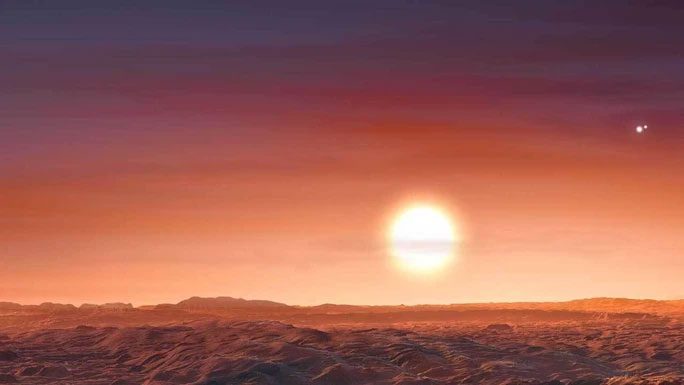This is a rocky planet named LTT 1445 Ac, orbiting a small red dwarf star.
The planet LTT 1445 Ac was initially detected by NASA’s TESS exoplanet-hunting telescope, residing in an unusual triple star system.
It orbits a single red dwarf star called LTT 1445 A, but if you were on this planet, you could also see the LTT 1445 B and LTT 1445 C stars, making the scenery on this planet reminiscent of a fictional world in the Star Wars universe.

The view on planet LTT 1445 Ac with three “red suns,” one nearby and two distant, from the LTT 1445 star system – (Graphic: NASA).
In a newly published study in the Astronomical Journal, a team led by Dr. Emili Pass from the Harvard & Smithsonian Center for Astrophysics (USA) discovered something even more remarkable: It belongs to the category of exoplanets with sizes similar to Earth.
This is precisely the type of planet that TESS aims to find, as a size comparable to our world is one of the primary factors indicating a planet’s potential for life.
Based on additional observations from the Hubble Space Telescope, American scientists calculated that this planet has a mass 1.37 times and a radius 1.07 times that of Earth.
Thus, its density is quite similar to that of Earth, reflecting its clear nature as a rocky planet, akin to our own.
The only unfortunate aspect is that this planet orbits its parent star too closely for comfort. Although this red dwarf is dimmer and cooler than our sun, with an orbital period of just 3.12 days, the surface temperature of this planet reaches up to 260 degrees Celsius.
This temperature is far too hot for any known forms of life on Earth. While this does not entirely rule out the possibility of life, the chances of potential life have significantly decreased.
However, with a distance of over 22 light-years and clear transit data from a special observation when it passed through the space between its parent star and Earth, scientists have a golden opportunity to study its atmosphere.
More detailed descriptions of this exoplanet could help scientists better understand how a world similar to our home planet might form and evolve in different star systems, thus narrowing down the search for life in the galaxy.





















































